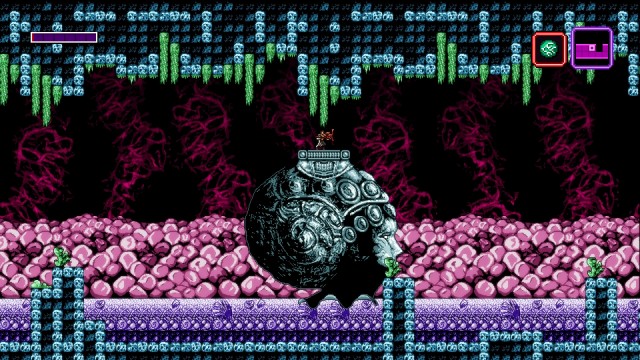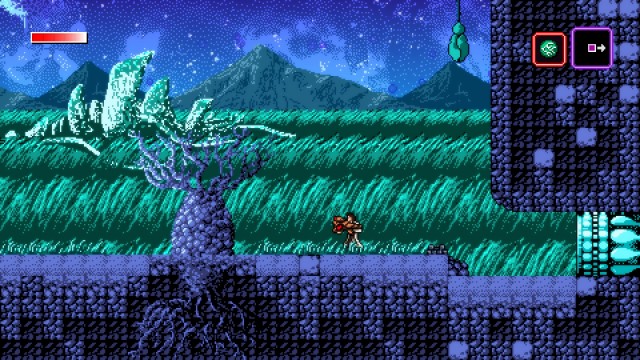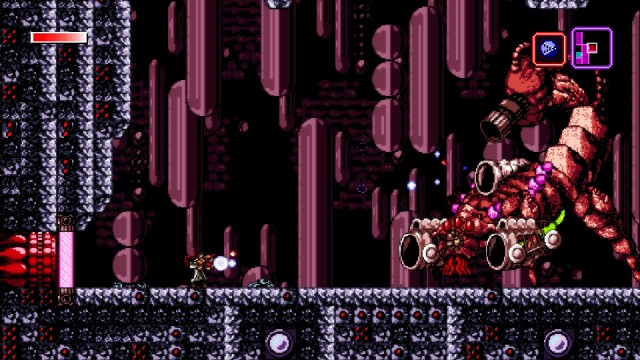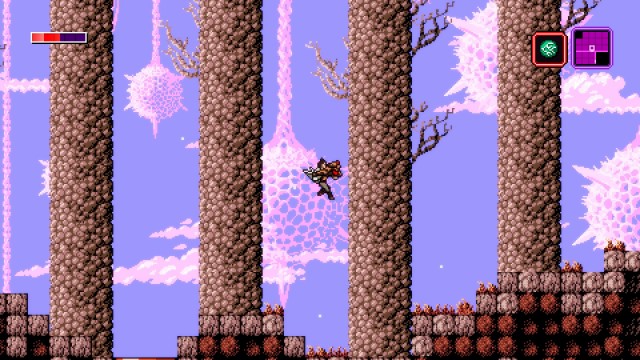
Another week, another Metroid-inspired action-platformer. That’s not a complaint, mind you, but it does seem to be a more frequent occurrence as of late. Thankfully, many of these recent releases have been solid, with a few standing out among the rest as the best the genre has to offer. Enter Axiom Verge, a game which proudly flaunts its Super Metroid-inspiration for all to see. It won’t win over any new players, but those fans that have seen many of Samus’ adventures will find plenty to like about this fresh take on a well-worn formula.
Two things stand out about Axiom Verge from the moment you have control of your character. The first is just how similar it is to Super Metroid, at least in the beginning, and the second is the gorgeous, nostalgia-fueled pixel-art style. Yeah, the visuals aren’t exactly groundbreaking, but the game manages to balance beauty and horror better than most.
One moment you’ll find yourself navigating an area of unspeakable horrors, such as piles of mutant corpses stacked up in the background, and the next you’ll stumble upon a seemingly vast landscape begging to be explored. Each individual area is lovingly crafted, but it’s the environmental variety where Axiom Verge truly shines. It’s remarkable, and you won’t find yourself in one particular area for too long before moving on to something new and exciting.

Axiom Verge will immediately feel not too dissimilar from Super Metroid once you have full control. It’s not a one-to-one comparison, but if you have any experience with Metroid titles, you’ll feel right at home here. That is, until you begin to discover the many surprising ways in which it differs from the norm. In many instances early on, you’ll find yourself stuck in a room you know you’ll be able to proceed through eventually, but at that moment cannot. “A wall that looks breakable can be destroyed with bombs, right?” Nope. “How about this small crawlspace? I’ll just use the inevitable morph-ball upgrade.” Not even close. It sets you up based on prior knowledge, but it brilliantly subverts those expectations whenever possible.
The weapons you pick up also help set Axiom Verge apart from its contemporaries, seeming less like Metroid and more like Contra. Each weapon has its particular uses, either for solving puzzles, defeating specific enemies or exposing a boss’s weakness. These include a short-range gun which shoots electricity in a manner similar to a shotgun, and a gun with projectiles which can explode into smaller projectiles with a second press of the fire button. You’ll undoubtedly have your favorites, but I always found myself switching up my strategies as I progressed because every gun was satisfying to use.
One major component of Axiom Verge is the way it utilizes “glitches.” As you explore the opening areas, you’ll come across these without any real context for the purpose they serve. It isn’t long before you get an upgrade which allows you to shoot a beam in order to break through these odd barriers. This upgrade is also used to discover hidden rooms, which quickly became an obsession of mine once I discovered certain parts of the wall contain said rooms. Hiding away some of the game’s secrets in areas you might only stumble upon is a little mean, sure, but it adds a new layer of depth to a genre which already evokes a sense of collection compulsion.

Best of all, this ability allows you to “glitch” any enemies you come across. Each enemy reacts to being hit by this ability differently. Some will shoot health orbs out instead of projectiles, while others will turn into platforms you can leap across to reach new areas. Incorporating enemies into traversal and environmental puzzle-solving isn’t entirely new to the genre, but it does provide you plenty of different opportunities to “defeat” (or at least weaken) enemies without relying simply on your available weapons.
Even if you take away Axiom Verge’s standout features, it presents a challenging Metroid-style experience. The controls are precise and satisfying, and the majority of the abilities you pick up along the way only add to the rewarding nature of the exploration. Unfortunately, not all of the abilities you come across are winners.
For example, as soon as I unlocked the grappling hook, I was pumped. “It’ll be just like Bionic Commando!,” I thought, before soon realizing how unintuitive the grappling controls were. The level of gratification I felt running around hit a wall once the grappling hook became a mainstay of the exploration, making each new grappling-focused platforming section feel more tedious than the last. I did eventually adjust to it, but it still put a damper on an otherwise-fantastic experience.

It doesn’t exactly create a new benchmark for a genre littered with copycats, but Axiom Verge is an excellent adventure with a healthy mix of new and old concepts. While it will never replace the classics, it’s nice to see developers continue to find new ways to pay homage to their inspirations and still create something unique in the process.
Pros: Excellent visuals and atmosphere, precise controls, nice variety of weapons and abilities
Cons: Some weak upgrades put a damper on platforming



















